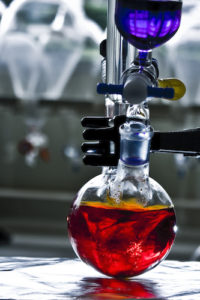Written by J.A Dobado | Last Updated on May 2, 2024

In this section, we describe a series of practices related to the reactivity of functional groups that are usually studied in an experimental course of Organic Chemistry.
Most of the experiments described correspond to one-step transformations. In addition, others deal with the multistep synthesis of a compound and the study of the concept of protective group within a synthetic route.
For this reason, in some cases a difunctional compound is also used. In this way, it will be used to develop the concept of chemoselectivity against different reagents but of the same family.
Experiment selection
The experiments have been chosen in order to have as wide a range of substrates as possible. Aliphatic or aromatic substrates have been selected, as well as different types of reagents. Also, various types of reactions have been taken into account: for example, substitution, elimination, addition, oxidation-reduction, etc. and reaction conditions (reflux, room temperature, cold, etc.). For this reason, the use of different methods of isolation and purification of organic compounds is also encouraged.
Likewise, the choice of the practicals has the ultimate goal of including the main basic laboratory operations in experiments of low or medium complexity, either as a whole or by choosing a few of them.
Accordingly, a selection of Organic Synthesis Experiments is listed below:
- Polystyrene production by radical polymerization
- Preparation of a synthetic detergent
- Obtaining biodiesel from vegetable oil
- Synthesis of aspirin
- Preparation of β-naphthyl methyl ether
- Preparation of 2-butoxynaphthalene
- Oxidation of 4-chlorobenzyl alcohol to 4-chlorobenzoic acid
- Claisen-Schmidt reaction: α,β-unsaturated ketones
- Benzaldehyde disproportionation (Cannizzaro reaction)
- Oxidation of cyclohexene to yield adipic acid
- Methyl benzoate nitration
- Synthesis of cinnamic acid
- Chemoselective reductions of 4-nitroacetophenone
- p-Nitroaniline synthesis
- Methyl benzoate nitration
- Synthesis of methyl orange
- Paracetamol synthesis
- Oxidation of acetophenone with sodium hypochlorite (haloform reaction)
- Synthesis of benzoic acid from Grignard reagent (phenylmagnesium bromide)
- Obtaining t-butyl chloride: use in the synthesis of 1,4-di-t-butylbenzene
- Obtaining phenolphthalein
- Acetanilide synthesis
- Dehydration of cyclohexanol to give cyclohexene
- Synthesis of Martius yellow dye
- Creatine synthesis (sports dietary supplement)
- Preparation of N-(p-chlorophenyl)-maleimide
- Chiral resolution of (±)-α-methylbenzylamine
- Oxidative coupling of alkynes (Glaser-Eglinton-Hay)
- Synthesis of acetylferrocene
- Reduction of cinnamaldehyde with LiAlH4
- Preparation of calix[4]pyrrole
- Conversion of citral to α- and β-ionone
- Reaction of cyclohexene with oxone
- Preparation of dibenzylamine hydrochloride
- Preparation of benzyl butyl ether
- Synthesis of γ-tert-butyl-ε-caprolactone from oxidation of 4-tert-butylcyclohexanone
- Synthesis of chiral ethyl 3-hydroxybutanoate
- Preparation of p-cymene from limonene
- Synthesis of racemic 1,1′-bi-2-naphthol
- Reaction of 4-nitrobenzaldehyde and dimedone
- Synthesis of 7-hydroxy-3-carboxycoumarin
- Synthesis of laurolactam from cyclododecanone
- Preparation of soap from vegetable oil
- Synthesis of nylon 6,6
- Preparation of 7,7-dichlorobicyclo[4.1.0]heptane
- Bromination of α-methylstyrene
- Synthesis of pinacol and pinacolone
- Production of adipic acid with H2O2/Na2WO4
- Bromine addition to cyclohexene
- Graphite-catalysed reaction of xylene with 2-bromopropane
- Obtaining ortho-nitrophenol
- Reaction of benzaldehyde with oxone
- Preparation of 5,5-bis(hydroxymethyl)-2-phenyl-1,3-dioxane in water
- Reaction of cyclohexanone with NaBH4
- Solvent-free Wittig reaction
- Reaction of 9-anthracenemethanol with N-methylmaleimide (Diels-Alder reaction in water)
- Obtaining phthalates from recycled polymers (PET)
- Producing slime (cross-linked biodegradable polymers)
- Polymers from starch
- Synthesis of tetrahydropyrimidinone (Biginelli reaction)
- Multi-component reaction in water (Passerini reaction)
- Preparation of meso-diethyl-2,2′-dipyrromethane in water
- Preparation of 1-butyl-3-methylimidazolium derivative (ionic liquid)
- Photochemical [2+2] cycloaddition of cinnamic acid to obtain truxillic acid
- Synthesis of 3‐methylcyclohex‐2‐enone
- Synthesis of (R)‐warfarin
- Synthesis of copper phthalocyanine
- Photochromic dimer from 2,4,5-triphenylimidazole
- Reduction of benzophenone into diphenylmethanol with NaBH4
- Acetophenone oxime preparation
Microscale Experiments
- Synthesis of 2-bromohexane
- Partial hydrogenation of a vegetable oil with cyclohexene and Pd(C) (margarine production)
- Isomerization of maleic acid (cis) to fumaric acid (trans)
- Ethyl iodide from ethanol
- Preparation of 4-methyl-3- and 4-methyl-2-nitroacetanilide from 4-methylaniline
- Synthesis of 2-iodobenzoic acid (Sandmeyer reaction)
- Compounds for the fragrance industry (ester synthesis)
- Preparation of 9-bromoanthracene
- KMnO4 oxidation of alkylbenzenes
- Synthesis of anthrone from anthraquinone
- Wintergreen oil from aspirin tablets
- Vanillin transformations
- Synthesis of 2,5-dimethyl-1-phenylpyrrole by Paal-Knorr reaction
References
- Isac-García, J.; Dobado, J. A.; Calvo-Flores, F. G.; and Martínez-García, H. (2015). Experimental Organic Chemistry Laboratory Manual. Elsevier Science & Technology. ISBN: 978-0-12-803893-2